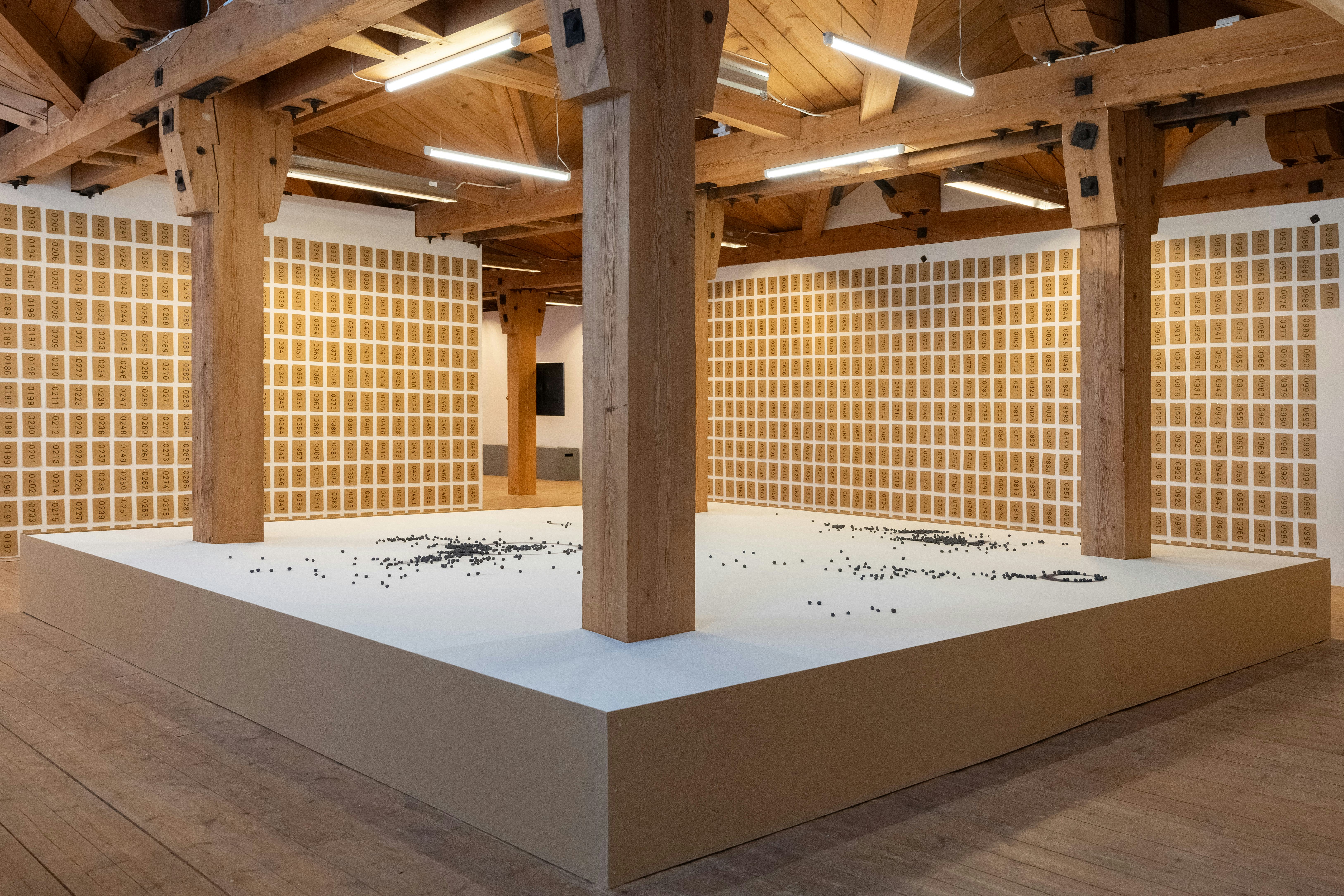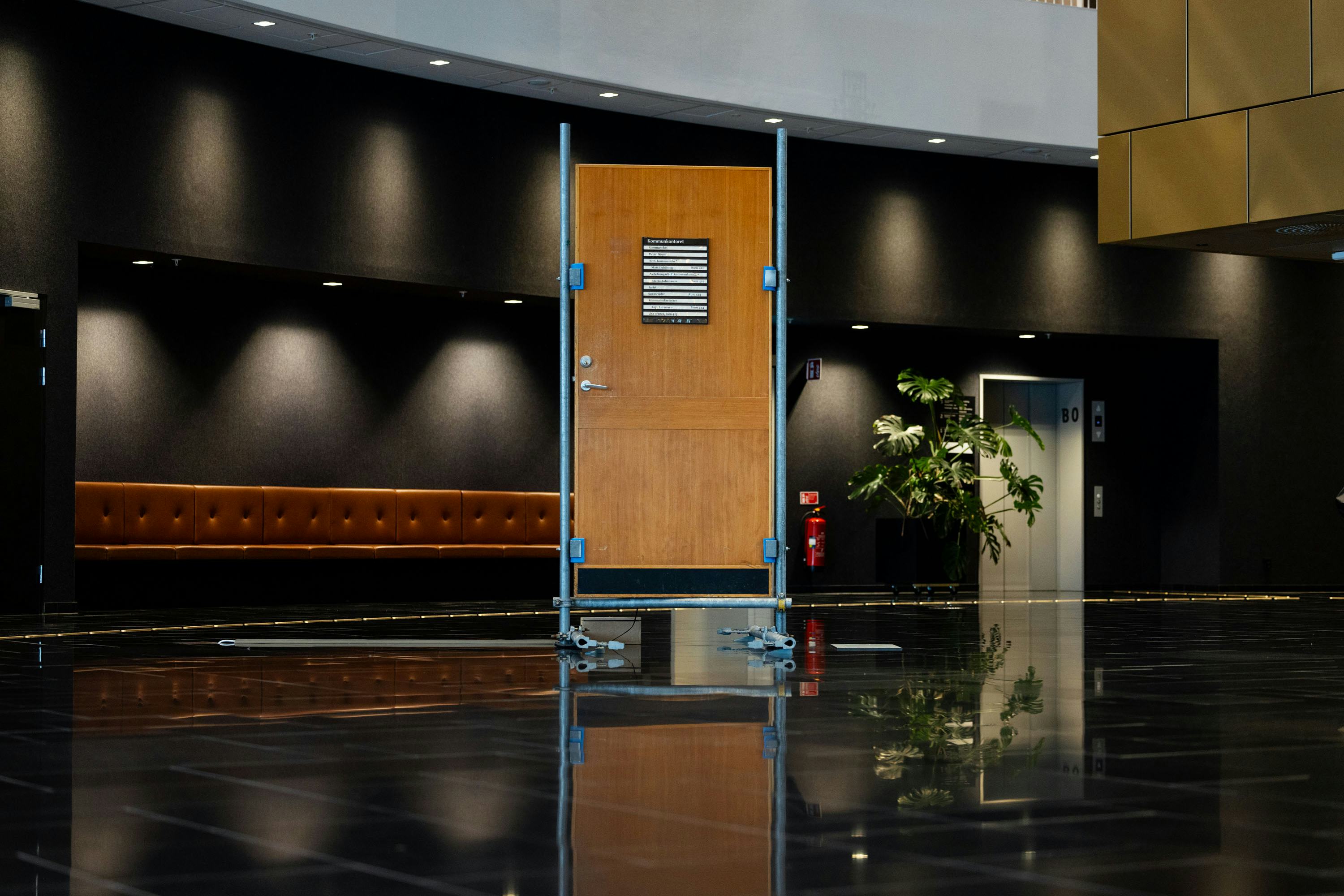LB°24 — Participants
ArchiveJenny Nordmark (b. 1980, Kalix, Sweden) explores, through art, architecture and scenography, issues connected to the climate, the local and the global.
On view in Havremagasinet, Boden
SPRÄNGSTEN, 2024
1000 iron ore pellets, paper bags, magnets, rotating mechanisms, contact microphone, stereo sound. Variable dimensions.
SPRÄNGSTEN is an installation with 1000 iron ore pellets, small spheres that serve as intermediary components between raw iron extraction and the final stages of steel production. These pellets come from the world's largest iron ore mine in Kiruna, operated by LKAB, a Swedish state-owned mining company which produces millions of metric tons of iron ore pellets annually. The artist managed to get the exhibited pellets during public guided tours of the mine, when LKAB allows over 20.000 annual visitors to take pellets as souvenirs.
The presence of these pellets in Havremagsinet, Boden, resonates with the route they go through in their journey towards steel. The iron ore extracted in the mines is transported either to Narvik or through Boden to Luleå. Boden is a central hub for future fossil-free steel production, with the company H2 Green Steel planning to commence large-scale production in 2026. Although such endeavours are important to Sweden's green transition, Boden grapples with financial challenges due to substantial investments, which generate a deficit that may persist until 2030, as assessed by SKR. And despite claiming environmentally sustainable operations, H2 Green Steel plans to import millions of tons of iron ore from Canada and Brazil, instead of using the ore produced in Norrbotten.
The exhibited pellets move unpredictably in response to the magnetic forces beneath the white horizontal surface on which they lie. Their magnetism is given by Magnetite, a magnetic mineral abundant in Norrbotten's iron ore deposits. As time progresses, the pellets’ movements draw subtle lines and traces on the white surface, accompanied by amplified sounds of their motions that introduce a time-based and sensorial layer to this evolving drawing. The erratic movements of the 1000 pellets hint to the nonsensical global transit of millions of tons of iron ore pellets, crossing vast distances propelled by economic forces.
An orthogonal grid covers the surrounding walls, composed by an assemblage of paper bags, some hand-stamped from 1 to 1000. As Luleåbiennalen concludes, visitors are invited to take home one pellet in a numbered bag. From this point, the pellets embark on new trajectories, diverging from magnetic forces and instead following individual routes. These paths symbolise the collective complicity and agency that individual trajectories possess, having the potential to fragment and challenge larger systems, while also being implicated in the shaping of the territories and lives that these systems govern.
SPRÄNGSTEN is part of a series exploring the interconnectedness of the built and natural environment, and specific materials, such as mining industry waste, in Sweden and globally.
Credits SPRÄNGSTEN
Graphic design: Research and Development
Photo: Jenny Nordmark
On view in Kiruna
FOLKMAKT, 2024
12 doors from Kiruna’s first City Hall- Igloo, precast construction fence elements, contact speakers, recorded speeches through impulse response from the former central hall of the Igloo, acrylic paint. Variable dimensions.
FOLKMAKT is a site-specific installation designed for Kiruna's new civic square, incorporating 12 doors collected from Kiruna’s initial City Hall, demolished in 2019. As a local historic landmark designed by architect Artur Von Schmalensee and opened in 1963, Kiruna’s City Hall named Igloo was affectionately referred to as Kiruna’s "living room." The Igloo’s doors carry symbolic importance, since they were the threshold between the spaces of the authorities in power and the main central hall, open to all citizens. Thus, underscoring the architect's ambition to establish a direct link between citizens and those in power. The central hall hosted exhibitions, parties, events, and rallies, including the significant Swedish miners’ strike of 1969–70, which paved the way for LAS, a law regulating employment conditions in Sweden. In 2001, the Igloo was designated a local historic landmark, but it was demolished due to the ongoing relocation of Kiruna’s city eastwards, despite a study indicating the feasibility of dismantling and reconstructing certain parts of the building.
FOLKMAKT is installed beside Kiruna’s new city hall called Kristallen, The Crystal, designed by Henning Larsen Architects and opened in 2018. Referencing the historical Igloo, Kristallen incorporates its iconic bell tower, original door handles, as well as selected materials, building components and art collection. FOLKMAKT’s doors are positioned beside this tower, forming a square shape reminiscent of the Igloo’s central hall, and fixed on prefabricated elements commonly found in construction sites throughout Kiruna.
The artist adds another layer to the installation by gathering images of doors from citizens’ houses in Kiruna and painting them onto the installation’s doors, drawing inspiration from trompe l'œil techniques and decorative painting used in scenography. The act of painting the doors outside during the exhibition becomes a catalyst for conversations with passers-by. During the Luleåbiennalen’s opening and closing events, citizens are invited to gather within the installation and express their views on significant issues and opportunities in Kiruna. Their narratives are recorded and played inside the Kristallen’s main foyer throughout the exhibition period using one of the Igloo’s doors as a loudspeaker, bringing the citizens’ voices into the new city hall.
Listen to the recording from the inauguration of FOLKMAKT by Jenny Nordmark, Karin Stöckel and Jari Söyrinki here.
Jenny Nordmark has studied art at the Royal Academy of Arts, HDK-Valand-Academy of Art and Design, performing arts at Stockholm's Dramatic College, and architecture at Chalmers University of Technology. During her public work for Jönköping municipality Nordmark started a non-profit association Rädda Konsten (2023–) which, among other things, plans a boat action on the lake Vättern in the summer of 2024. Previous works include a regional art project for Konstmuseet i Norr, SE (2021), participation in a group exhibition in the Swedish pavilion at the Venice biennial, IT (2018) and an exhibition at The Royal Swedish Academy of Fine Arts, SE (2015).
Händelsernas Centrum
Part of the artist's contributions to the Luleå Biennial 2024 was created as part of Händelsernas Centrum: a project which creates art experiences that contribute concrete examples of how culture and art affect our living environments, experiences of places and our moods during ongoing and imminent changes. Händelsernas Centrum is co-funded by the European Union and carried out with support from the Swedish Board of Agriculture, and Leader Tornedalen 2030, LKAB and Kiruna kommun.

